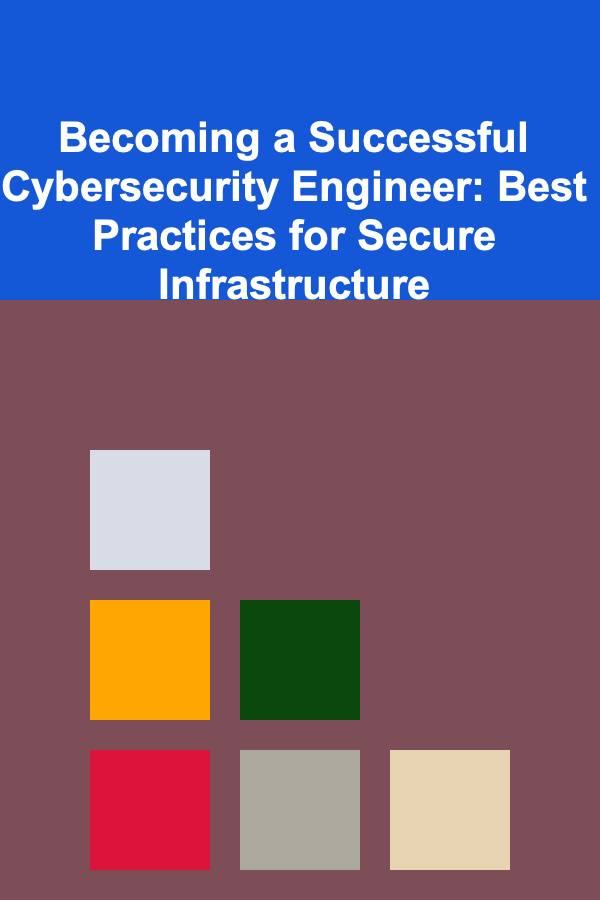
Becoming a Successful Cybersecurity Engineer: Best Practices for Secure Infrastructure
ebook include PDF & Audio bundle (Micro Guide)
$12.99$5.99
Limited Time Offer! Order within the next:

In an increasingly digital world, cybersecurity has become one of the most critical pillars for organizations. Cybersecurity engineers play a central role in defending the infrastructure, applications, and data from cyber threats. As cyberattacks evolve, cybersecurity engineers must adapt, continuously learning and applying the best practices to keep systems secure. This actionable guide will provide insights into how to become a successful cybersecurity engineer by adopting effective strategies and practices to build and maintain secure infrastructure.
Mastering Core Cybersecurity Principles
Before diving into advanced techniques and tools, it's essential to understand the fundamental principles of cybersecurity. These foundational concepts serve as the bedrock upon which you can build your knowledge and expertise.
1.1 Confidentiality, Integrity, and Availability (CIA Triad)
The CIA Triad is the cornerstone of cybersecurity and encompasses three key objectives:
- Confidentiality: Ensuring that sensitive data is only accessible to those with the appropriate permissions.
- Integrity: Safeguarding the accuracy and reliability of data, preventing unauthorized modifications.
- Availability: Ensuring that systems and data are accessible to authorized users when needed.
Understanding how to maintain and prioritize these principles is vital in creating secure systems.
1.2 Defense in Depth
This strategy involves layering multiple defenses across the network and infrastructure. If one layer fails, others will still be in place to protect against attacks. Examples of defense in depth include:
- Firewalls and intrusion prevention systems (IPS)
- Encryption of sensitive data
- Secure user authentication and access control
- Monitoring and logging for suspicious activities
1.3 Least Privilege and Zero Trust Architecture
The principle of least privilege means that users and systems should only have the minimum level of access required to perform their tasks. Zero Trust Architecture builds on this by assuming no user or system is inherently trusted, whether inside or outside the network. Every access request must be verified.
Developing a Comprehensive Security Strategy
As a cybersecurity engineer, your role extends beyond just configuring firewalls and performing vulnerability scans. Building a robust security strategy that aligns with business goals is key to ensuring that the infrastructure remains protected. Here are some best practices for building such a strategy:
2.1 Perform Regular Risk Assessments
Risk assessments are the backbone of any security strategy. By identifying potential threats, vulnerabilities, and the impact of different attack scenarios, you can prioritize security measures that mitigate the most significant risks.
- Asset Identification: Know what you're protecting. This includes servers, networks, applications, databases, and intellectual property.
- Threat Modeling: Understand potential threat actors, whether internal or external, and how they could exploit vulnerabilities.
- Impact Analysis: Evaluate the potential damage of different attacks, such as data breaches, ransomware, and denial-of-service attacks.
2.2 Secure the Network Infrastructure
Network security is one of the most critical components of a secure infrastructure. Cybersecurity engineers must implement measures that safeguard the network from external and internal threats.
- Firewalls and IDS/IPS: These are essential for filtering traffic, blocking unauthorized access, and detecting malicious activities.
- VPNs and Encryption: Virtual private networks (VPNs) help protect data in transit, while encryption ensures that sensitive data remains private, even if intercepted.
- Segmentation and Micro-Segmentation: Network segmentation divides the network into smaller zones to limit the spread of attacks. Micro-segmentation further isolates individual systems to prevent lateral movement.
2.3 Patch Management and Vulnerability Scanning
Regular patching is one of the most effective ways to keep systems secure. Ensure that software, operating systems, and applications are updated regularly to fix known vulnerabilities. Vulnerability scanning tools should also be used to detect unpatched systems.
- Automated Patching: Implement tools that automate patching on critical systems to ensure that security vulnerabilities are addressed as soon as they are discovered.
- Vulnerability Scanners: Use tools like Nessus, Qualys, or OpenVAS to perform regular scans on your infrastructure to identify weaknesses before attackers can exploit them.
2.4 Security Logging and Monitoring
Real-time monitoring and auditing of your systems can help you detect and respond to potential attacks quickly. By maintaining detailed security logs, you'll have insight into what's happening in your environment.
- SIEM Systems: Security Information and Event Management (SIEM) tools like Splunk, IBM QRadar, and ELK Stack aggregate logs from various sources, enabling quicker threat detection and response.
- Alerting: Set up automated alerts for abnormal activities like failed login attempts, privilege escalations, or unusual network traffic to respond before issues escalate into full-blown incidents.
Securing Applications and Development Practices
As organizations increasingly rely on web-based applications and services, securing applications becomes a critical responsibility of cybersecurity engineers. Here are some ways to integrate security practices into the development process:
3.1 Secure Software Development Life Cycle (SDLC)
The SDLC should incorporate security at every phase, from planning through design and development to testing and deployment. By adopting security best practices early in the development process, you can minimize vulnerabilities in the final product.
- Threat Modeling in the Design Phase: Identify potential security risks during the design phase and integrate mitigation strategies into the architecture.
- Code Review and Static Analysis: Conduct regular code reviews and use static application security testing (SAST) tools to find vulnerabilities such as SQL injection, cross-site scripting (XSS), and buffer overflows.
- Penetration Testing: Before deployment, use penetration testing (pen testing) to simulate real-world attacks and find weaknesses.
3.2 Secure Code Practices
Encourage developers to follow secure coding guidelines such as the OWASP Top Ten, which outlines the most critical security risks for web applications. These include:
- Input Validation: Never trust user input. Validate and sanitize inputs to prevent attacks like SQL injection and cross-site scripting (XSS).
- Authentication and Authorization: Ensure strong password policies, multi-factor authentication (MFA), and proper access control mechanisms are in place.
- Session Management: Secure session tokens and ensure that sessions expire after a reasonable period.
Incident Response and Recovery
Despite all your efforts, breaches may still occur. Cybersecurity engineers must be prepared with a robust incident response plan to quickly identify, contain, and mitigate the effects of a security breach. Here's how to build a resilient incident response framework:
4.1 Develop an Incident Response Plan (IRP)
Your IRP should outline clear steps for addressing various types of security incidents. The plan should include:
- Detection: Set up tools and processes for quickly identifying breaches or suspicious activity.
- Containment: Define steps to isolate compromised systems to prevent further damage.
- Eradication: Remove the root cause of the incident, such as malware or unauthorized access.
- Recovery: Restore systems to normal operation as quickly as possible, ensuring data integrity and security.
- Post-Incident Review: After an incident, conduct a post-mortem to identify what went wrong and how future incidents can be prevented.
4.2 Backup and Disaster Recovery
Ensure that all critical systems and data are backed up regularly. A disaster recovery plan should be in place to restore services in the event of a breach or catastrophic failure.
- Data Encryption: Encrypt backups to ensure that they remain secure, even if attackers gain access to backup systems.
- Offsite Backups: Store backups in a secure offsite location, either physically or in the cloud, to safeguard against data loss.
Staying Current in the Field
The field of cybersecurity is dynamic, with new threats, tools, and strategies emerging all the time. To stay relevant as a cybersecurity engineer, you must continuously learn and adapt:
- Certifications: Certifications like CISSP, CEH, CompTIA Security+, and OSCP demonstrate your expertise and commitment to continuous learning.
- Conferences and Communities: Attend cybersecurity conferences, webinars, and forums to stay up-to-date with the latest trends and network with other professionals.
- Continuous Practice: Build and maintain a home lab where you can experiment with new tools, simulate attacks, and practice response techniques.
Conclusion
Becoming a successful cybersecurity engineer requires a comprehensive understanding of core cybersecurity principles, technical expertise, and a proactive approach to securing infrastructure. By mastering network security, patch management, secure development practices, and incident response, cybersecurity engineers can play a pivotal role in protecting organizations from the ever-evolving landscape of cyber threats. In addition, continuous learning and adaptation are critical in staying ahead of emerging risks and technologies. By following these best practices, you'll be well-equipped to safeguard your organization's assets and infrastructure.
Reading More From Our Other Websites
- [Personal Financial Planning 101] How to Save for Your Child's Education Without Stress
- [Home Staging 101] How to Stage Your Home to Showcase Its Potential
- [Simple Life Tip 101] Best Simple‑Living Mindfulness Practices for High‑Pressure Jobs
- [Personal Finance Management 101] How to Save Money While Traveling Without Compromising Experiences
- [Personal Care Tips 101] How to Use Blush to Add Warmth to Your Winter Makeup Routine
- [Personal Care Tips 101] How to Make Your Lips Appear Fuller with the Right Lipstick
- [Home Soundproofing 101] How to Soundproof Your Ceiling to Reduce Noise from Above
- [Personal Care Tips 101] How to Use Face Serum to Minimize Pores and Tighten Skin
- [Star Gazing Tip 101] Solo Star-Gazing: How to Choose the Perfect Dark-Sky Destination for One
- [Home Security 101] How to Secure Your Home with Outdoor Lighting

Beginner's Guide to Home Organization: A Comprehensive, Actionable Approach
Read More
How to Organize Your Pantry for Special Diets (e.g., Gluten-Free, Vegan)
Read More
How to Store Seasonal Items Effectively in Your Home
Read More
How to Use Drawer Dividers for Tidy Kitchen Storage
Read More
Navigating Legal Requirements for Startups: A Comprehensive Guide
Read More
10 Tips for Bowling in a League: Strategies and Etiquette
Read MoreOther Products

Beginner's Guide to Home Organization: A Comprehensive, Actionable Approach
Read More
How to Organize Your Pantry for Special Diets (e.g., Gluten-Free, Vegan)
Read More
How to Store Seasonal Items Effectively in Your Home
Read More
How to Use Drawer Dividers for Tidy Kitchen Storage
Read More
Navigating Legal Requirements for Startups: A Comprehensive Guide
Read More